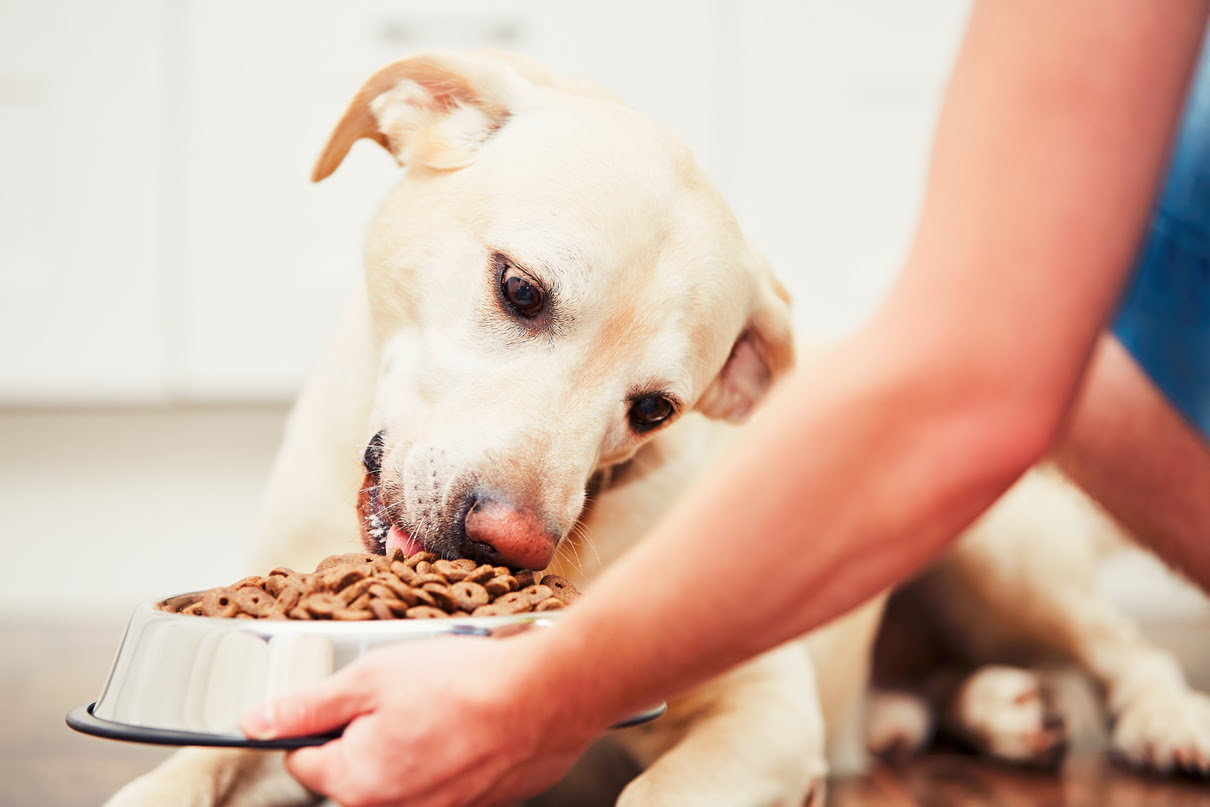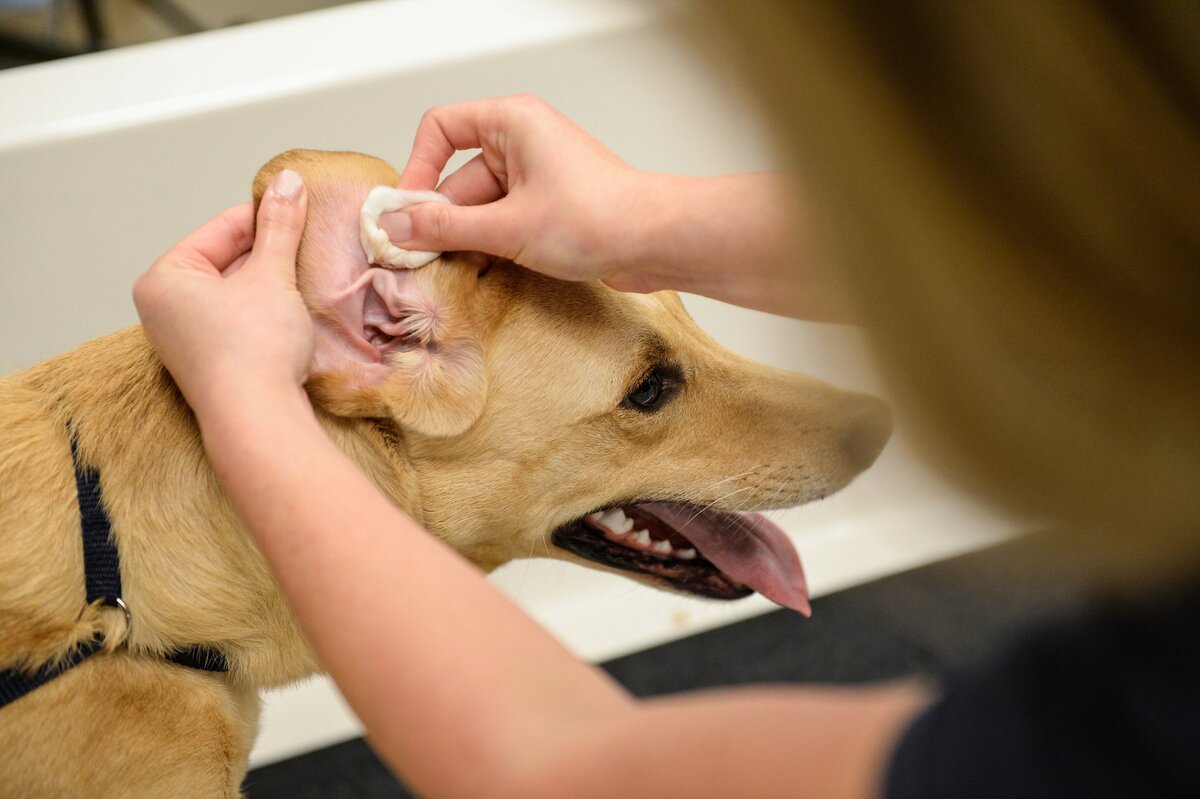Home>Health & Wellness>Common Health Issues>What To Give A Diabetic Dog With Low Blood Sugar


Common Health Issues
What To Give A Diabetic Dog With Low Blood Sugar
Published: January 31, 2024
Learn how to manage low blood sugar in diabetic dogs and other common health issues. Find the best treatment options and care tips for your furry friend.
(Many of the links in this article redirect to a specific reviewed product. Your purchase of these products through affiliate links helps to generate commission for Pawsomeoldies.com, at no extra cost. Learn more)
Table of Contents
Introduction
Diabetes is a common health issue that affects not only humans but also our beloved canine companions. When a dog is diagnosed with diabetes, it means their body is unable to regulate blood sugar levels effectively. This can lead to various complications, including the potentially dangerous condition of low blood sugar, also known as hypoglycemia. Understanding how to manage and support a diabetic dog with low blood sugar is crucial for their well-being and overall quality of life.
In this comprehensive guide, we will delve into the essential aspects of caring for a diabetic dog experiencing low blood sugar. From recognizing the signs and symptoms to exploring effective treatment options and dietary considerations, we aim to provide valuable insights for pet owners facing this challenging situation. By gaining a deeper understanding of low blood sugar in diabetic dogs and learning how to address it proactively, you can help ensure the health and happiness of your furry friend.
Throughout this article, we will emphasize the importance of vigilance and proactive management when it comes to supporting a diabetic dog with low blood sugar. By staying informed and taking the necessary steps to monitor and address this condition, pet owners can play a pivotal role in safeguarding their dog's well-being. Additionally, we will highlight the significance of a balanced and appropriate diet in managing low blood sugar in diabetic dogs, offering practical guidance on the types of foods that can help stabilize their blood sugar levels.
As we navigate the complexities of managing low blood sugar in diabetic dogs, it's essential to approach the topic with empathy and a genuine commitment to providing the best possible care for our furry companions. With this in mind, let's embark on a journey to gain a deeper understanding of this critical aspect of canine health and well-being.
Understanding Low Blood Sugar in Diabetic Dogs
Low blood sugar, or hypoglycemia, is a common concern for diabetic dogs and can have serious implications for their health. In diabetic dogs, the body's ability to regulate blood sugar levels is compromised, leading to fluctuations that can result in low blood sugar episodes. Understanding the underlying causes and dynamics of low blood sugar in diabetic dogs is crucial for pet owners to effectively manage this condition.
When a diabetic dog experiences low blood sugar, it means that the glucose levels in their bloodstream have dropped below the normal range. This can occur due to various factors, including an imbalance between insulin levels and food intake, excessive physical activity, delayed or missed meals, or an insulin overdose. Additionally, certain medications and underlying health issues can contribute to the onset of hypoglycemia in diabetic dogs.
The symptoms of low blood sugar in diabetic dogs can manifest in diverse ways, ranging from mild to severe. Common signs include weakness, lethargy, disorientation, trembling, excessive hunger, and in some cases, seizures. It's essential for pet owners to be vigilant and recognize these symptoms promptly, as untreated hypoglycemia can lead to further complications and potentially life-threatening situations for the dog.
Managing low blood sugar in diabetic dogs involves a multi-faceted approach, encompassing careful monitoring, timely intervention, and proactive measures to prevent recurrent episodes. This often entails maintaining a consistent feeding schedule, administering insulin as prescribed by a veterinarian, and closely observing the dog's behavior and energy levels. Additionally, pet owners should be prepared to address low blood sugar emergencies by having readily accessible sources of glucose, such as honey or glucose gel, to administer to their dog when needed.
Furthermore, understanding the individual factors that can trigger low blood sugar in a diabetic dog is essential for devising a tailored management plan. Factors such as the dog's age, weight, activity level, and overall health status can influence their susceptibility to hypoglycemia, necessitating personalized care and attention.
By gaining a comprehensive understanding of the intricacies of low blood sugar in diabetic dogs, pet owners can empower themselves to provide the necessary support and intervention when their canine companion experiences fluctuations in blood sugar levels. This knowledge forms the foundation for effective management and proactive measures to safeguard the well-being of diabetic dogs, ultimately contributing to their long-term health and quality of life.
Signs and Symptoms of Low Blood Sugar in Diabetic Dogs
Recognizing the signs and symptoms of low blood sugar, or hypoglycemia, in diabetic dogs is paramount for pet owners to intervene promptly and effectively. Understanding these indicators can enable proactive management and timely support, potentially averting serious complications for the dog.
The manifestations of low blood sugar in diabetic dogs can vary in intensity and may include subtle behavioral changes or more pronounced physical symptoms. One of the most common signs is weakness or lethargy, where the dog appears unusually tired or lacks energy compared to their typical demeanor. This can be accompanied by disorientation or confusion, as the dog may exhibit uncharacteristic behaviors or seem unaware of their surroundings.
Another prominent symptom is trembling or shaking, often noticeable in the dog's body or limbs. This trembling may be accompanied by an apparent increase in hunger, with the dog displaying a heightened interest in food or exhibiting persistent begging behavior. In some cases, a diabetic dog experiencing low blood sugar may exhibit signs of nervousness or anxiety, reflecting the physiological impact of hypoglycemia on their overall well-being.
As the condition progresses, more severe symptoms may emerge, including seizures or convulsions. These episodes can be distressing for both the dog and their owner, underscoring the urgency of addressing low blood sugar promptly and effectively. Additionally, a diabetic dog in a hypoglycemic state may display a lack of coordination or balance, further highlighting the disruptive effects of low blood sugar on their physical and neurological functions.
It's important for pet owners to observe their diabetic dog closely for these signs and symptoms, especially during key times such as after insulin administration or following periods of increased physical activity. By remaining vigilant and attuned to their dog's behavior, pet owners can detect early warning signs of low blood sugar and take proactive measures to address the situation.
In summary, the signs and symptoms of low blood sugar in diabetic dogs encompass a spectrum of indicators, ranging from subtle changes in behavior to more pronounced physical manifestations. By familiarizing themselves with these signs, pet owners can cultivate a heightened awareness of their dog's well-being and respond effectively to fluctuations in blood sugar levels, ultimately contributing to the dog's overall health and quality of life.
Treatment Options for Diabetic Dogs with Low Blood Sugar
When a diabetic dog experiences low blood sugar, prompt and appropriate treatment is essential to stabilize their condition and prevent potential complications. The primary goal of treatment for low blood sugar, or hypoglycemia, in diabetic dogs is to raise their blood glucose levels to a safe range while addressing the underlying cause of the episode. Here are the key treatment options and interventions for managing low blood sugar in diabetic dogs:
1. Oral Glucose Administration:
Administering a small amount of glucose orally can rapidly elevate a diabetic dog's blood sugar levels. This can be achieved by offering the dog a small amount of honey, maple syrup, or glucose gel, which is readily absorbed and can provide a quick source of energy. Pet owners should be cautious not to administer excessive amounts of glucose, as this can lead to a rapid spike in blood sugar levels, followed by a subsequent drop.
2. Injectable Glucose:
In cases of severe hypoglycemia or when a diabetic dog is unable to consume oral glucose, injectable glucose may be necessary. Veterinarians may prescribe a specific type of injectable glucose solution to be used in emergency situations, providing a rapid and direct means of raising the dog's blood sugar levels. Pet owners should receive proper training and guidance from their veterinarian on the correct administration of injectable glucose.
3. Adjusting Insulin Dosage:
For diabetic dogs receiving insulin therapy, adjusting the insulin dosage under the guidance of a veterinarian is crucial to prevent recurrent episodes of low blood sugar. This may involve modifying the timing or dosage of insulin injections to achieve a more balanced and stable blood sugar profile. Close collaboration with a veterinarian is essential to ensure that any adjustments to insulin therapy are made in a safe and effective manner.
4. Dietary Management:
Maintaining a consistent and balanced diet is integral to managing low blood sugar in diabetic dogs. Ensuring that the dog receives regular meals at scheduled intervals, along with appropriate portions of high-quality, nutritionally balanced food, can help stabilize their blood sugar levels. Additionally, incorporating complex carbohydrates and lean proteins into the dog's diet can contribute to sustained energy release and better blood sugar regulation.
5. Monitoring and Follow-Up:
After an episode of low blood sugar, diligent monitoring of the diabetic dog's condition is essential to assess their response to treatment and identify any potential recurrence of hypoglycemia. Regular follow-up appointments with a veterinarian allow for ongoing evaluation of the dog's overall health and the effectiveness of their diabetes management plan. This proactive approach enables adjustments to be made as needed, optimizing the dog's long-term well-being.
By implementing these treatment options and interventions, pet owners can effectively address low blood sugar in diabetic dogs, promoting stability and minimizing the risk of future hypoglycemic episodes. Collaborating closely with a veterinarian and adhering to a comprehensive management plan tailored to the dog's specific needs are fundamental to ensuring optimal care and support for diabetic dogs facing the challenges of low blood sugar.
Read more: What Is Blood Parasite Test For Dogs
Foods to Give a Diabetic Dog with Low Blood Sugar
When a diabetic dog experiences low blood sugar, providing the right foods can play a crucial role in stabilizing their condition and restoring healthy glucose levels. Selecting appropriate foods that can help raise the dog's blood sugar in a controlled manner is essential for managing hypoglycemia effectively. Here are some recommended foods to give a diabetic dog with low blood sugar:
1. High-Glucose Fruits:
- Bananas: Rich in natural sugars, bananas can serve as a quick source of energy to elevate a diabetic dog's blood sugar levels. Offering small pieces of ripe banana can help address mild hypoglycemia.
- Berries: Blueberries, strawberries, and raspberries contain natural sugars and can be beneficial in raising a diabetic dog's blood sugar. These fruits can be offered in moderation to provide a gentle increase in glucose levels.
2. Complex Carbohydrates:
- Sweet Potatoes: Cooked sweet potatoes are a valuable source of complex carbohydrates, offering sustained energy release and aiding in stabilizing blood sugar levels. Serving mashed or boiled sweet potatoes in small portions can be beneficial for diabetic dogs experiencing low blood sugar.
- Brown Rice: Incorporating cooked brown rice into the dog's diet can contribute to a gradual increase in blood sugar, supporting a more sustained and balanced response compared to simple sugars.
3. Lean Proteins:
- Boiled Chicken: Lean, boiled chicken can provide essential protein without significantly impacting blood sugar levels. Offering small amounts of plain, cooked chicken can help maintain the dog's energy levels without causing rapid fluctuations in glucose.
- Turkey: Similarly, cooked turkey can serve as a lean protein source that supports the diabetic dog's nutritional needs while minimizing the risk of exacerbating low blood sugar.
Read more: When To Give A Diabetic Dog Insulin
4. Balanced Dog Food:
- Specialized Diabetic Dog Food: There are commercially available dog foods specifically formulated for diabetic dogs, designed to support stable blood sugar levels and overall health. These specialized diets often contain a balanced combination of complex carbohydrates, lean proteins, and essential nutrients tailored to the unique dietary requirements of diabetic dogs.
It's important to note that while these foods can help raise a diabetic dog's blood sugar, portion control and moderation are key considerations. Pet owners should work closely with their veterinarian to determine the most suitable dietary approach for their diabetic dog, taking into account the dog's individual health status and nutritional needs.
By incorporating these recommended foods into the diabetic dog's diet, pet owners can contribute to managing low blood sugar effectively, promoting stable glucose levels and supporting the dog's overall well-being. Additionally, maintaining a consistent feeding schedule and adhering to a balanced, tailored diet plan can play a pivotal role in preventing recurrent episodes of hypoglycemia, ultimately enhancing the quality of life for diabetic dogs.
Monitoring and Preventing Low Blood Sugar in Diabetic Dogs
Monitoring and preventing low blood sugar, or hypoglycemia, in diabetic dogs is a critical aspect of proactive care aimed at safeguarding their well-being and minimizing the risk of potentially dangerous fluctuations in blood sugar levels. By implementing vigilant monitoring practices and adopting preventive measures, pet owners can play a pivotal role in managing their diabetic dog's condition effectively.
Regular Blood Glucose Monitoring:
Consistent monitoring of a diabetic dog's blood glucose levels is fundamental to detecting any deviations from the target range and addressing them promptly. This often involves using a glucometer to measure the dog's blood sugar levels at home, under the guidance of a veterinarian. By establishing a routine for blood glucose monitoring, pet owners can gain valuable insights into their dog's response to insulin therapy, dietary adjustments, and overall management of diabetes.
Observing Behavioral and Physical Cues:
In addition to blood glucose monitoring, pet owners should remain attuned to their diabetic dog's behavior and physical well-being. Observing for subtle cues such as changes in energy levels, appetite, and overall demeanor can provide early indications of potential fluctuations in blood sugar. By maintaining a keen awareness of their dog's behavior, pet owners can intervene proactively at the first signs of low blood sugar, mitigating the risk of more severe hypoglycemic episodes.
Read more: What Causes Blood Cancer In Dogs
Consistent Feeding Schedule:
Establishing a consistent feeding schedule for diabetic dogs is integral to preventing low blood sugar. Regular, balanced meals at scheduled intervals help maintain stable blood glucose levels and minimize the likelihood of significant fluctuations. Pet owners should work closely with their veterinarian to devise a feeding regimen tailored to their dog's specific dietary requirements, ensuring that meals align with insulin administration and the dog's overall metabolic needs.
Regular Exercise and Activity Management:
Balanced and moderate exercise is beneficial for diabetic dogs, contributing to overall health and well-being. However, it's essential to manage the dog's activity levels to prevent excessive exertion that could lead to rapid depletion of glucose stores. By incorporating regular, controlled exercise into the dog's routine and avoiding prolonged periods of strenuous activity, pet owners can help regulate their dog's energy expenditure and minimize the risk of hypoglycemia.
Collaborative Care with a Veterinarian:
Maintaining open communication and collaboration with a veterinarian is paramount in the ongoing monitoring and prevention of low blood sugar in diabetic dogs. Regular veterinary check-ups, discussions about the dog's response to treatment, and adjustments to the diabetes management plan are essential components of proactive care. By partnering with a veterinarian, pet owners can receive tailored guidance and support, ensuring that their diabetic dog's health is consistently monitored and optimized.
By integrating these monitoring and preventive measures into the daily care routine for diabetic dogs, pet owners can significantly reduce the risk of low blood sugar episodes and contribute to the dog's long-term health and quality of life. Proactive management, informed decision-making, and a commitment to personalized care form the cornerstone of effective monitoring and prevention strategies, ultimately benefiting the well-being of diabetic dogs.
Conclusion
In conclusion, the management of low blood sugar in diabetic dogs is a multifaceted endeavor that demands vigilance, proactive intervention, and a deep understanding of the unique needs of canine companions facing this health challenge. By recognizing the signs and symptoms of hypoglycemia, pet owners can respond promptly and effectively, mitigating the potential risks associated with fluctuating blood sugar levels. Understanding the underlying dynamics of low blood sugar in diabetic dogs empowers pet owners to implement tailored treatment options and dietary strategies, fostering stability and promoting the dog's overall well-being.
The significance of a balanced and appropriate diet in managing low blood sugar cannot be overstated. Selecting foods that support controlled increases in blood glucose levels, such as high-glucose fruits, complex carbohydrates, and lean proteins, forms a cornerstone of effective dietary management for diabetic dogs. Coupled with consistent feeding schedules and close collaboration with veterinarians, these dietary considerations contribute to stabilizing blood sugar levels and minimizing the risk of hypoglycemic episodes.
Furthermore, proactive monitoring and preventive measures are essential components of comprehensive care for diabetic dogs. Regular blood glucose monitoring, attentive observation of behavioral cues, and the establishment of consistent routines for feeding and exercise enable pet owners to anticipate and address potential fluctuations in blood sugar, fostering a proactive approach to managing low blood sugar.
By embracing these principles of proactive care, pet owners can navigate the complexities of supporting diabetic dogs with low blood sugar, ultimately enhancing the dog's quality of life and fostering a nurturing environment that prioritizes their health and well-being. Through ongoing collaboration with veterinarians and a commitment to personalized care, pet owners can navigate the challenges of managing low blood sugar in diabetic dogs with confidence and compassion, ensuring that their beloved companions receive the support and attention they need to thrive despite the complexities of diabetes.











